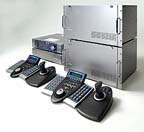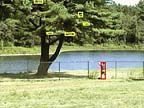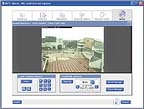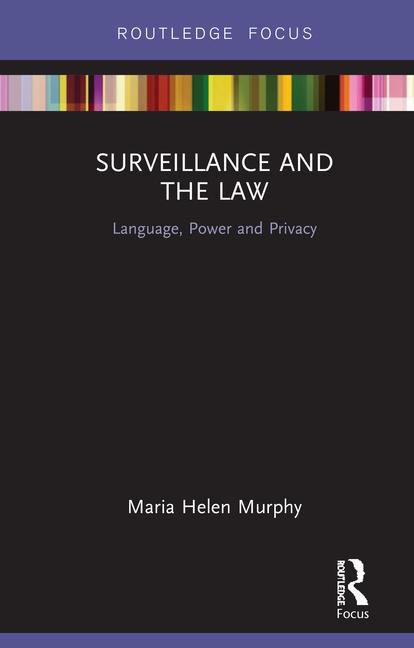They Think, Talk, Act

A surveillance system today can easily have hundreds of cameras. It would take several operators to view this many cameras even with a sequencing system switching four monitors per operator every ten seconds. This arrangement still leaves too much time between images for adequate surveillance, not to mention the fatigue factor it induces in human operators.
The answer is either more staff to monitor the video, which could become cost prohibitive, or a system that is intelligent enough to analyze incoming video, detect a problem and signal for a response or initiate a predetermined one.
Manufacturers worldwide are adding algorithms to video surveillance systems designed to take on a variety of analytical tasks. The primary function of these new video analysis features is to relieve security video operators from the stress of monitoring too many screens of information. As is usually the case with technology, many unexpected benefits have come into play as well.
In the past, security video surveillance was used primarily in post-event criminal proceedings. Today, intelligent systems are crime prevention tools as well as provide additional business benefits that result in a better return on investment for buyers.

Cost impact
Currently, intelligent video technology is being used principally for Homeland Security applications, owing to high costs. But as costs come down, such technology can be expected to be used more and more in the private sector. Initial trials by Homeland Security purchasers should unearth and remedy many of the bugs that naturally occur in software-based systems, so that the next wave of users has a much smoother introduction to the intelligent technologies.
Resolution vs. intelligence
The security industry uses a variety of terms for intelligent video – some that have been adopted from the world of computer science and machine vision, and some that simply imply the benefits of the systems. The term actually refers to the analysis and extraction of video information with specific reasoning attached for specific applications. With intelligent video, it may be determined that certain video data is not of high priority so resolution can be decreased to conserve bandwidth or storage space. Intelligent video can refer to content management, such as indexing and retrieval, and can do things like automatically enhancing an image by removing noise, improving resolution or increasing dynamic range.Today’s software programs analyze scenes in a camera view and provide directional motion, unattended baggage and abandoned vehicle detection, image stabilization, object classification, access control monitoring, people and traffic counting, license plate and facial recognition, behavioral analysis, trending, and an ongoing wealth of features. These surveillance systems can make decisions about images based on the confirmation or violation of preset protocols.
An intelligent video system can identify predetermined behaviors such as someone lying on the floor, erratic movements and people or cars converging on each other; a person, item or vehicle staying in one place for an extended period; a person or vehicle traveling against the normal flow; or objects newly appearing on the scene.
Some behavior recognition programs even utilize recursive adaptive computer algorithms. These are dynamic programs where normal patterns of behavior are continually learned and updated to define acceptable behavior patterns. These types of programs are very reliable, as they will alert on all anomalies and not just those that have been previously identified.

Multi-technologies
Generally, today’s systems are scalable and upgradeable, high-resolution, color systems with sensors and databases. They are biometric-enabled and have 3D image analyzers that perform multiple tasks including identifying, tracking, determining motives behind movements, broadcasting and storage.The intelligent video system can be programmed for a variety of uses. Many systems will have features allowing them to audibly instruct intruders to disband before further action is taken to remove them from the area.
Automatic detection and subsequent alert of suspicious bags and packages can provide the exact location of a questionable object and a possible identification of its category or type based on factors like size, shape, etc. Nice Systems, headquartered in Israel, is well known for its Unattended Baggage Detection application.
Nice Systems created this analytical feature by using a DSP-based real-time video object tracking and analysis platform.
Detecting objects
A similar feature is used to eliminate illegally parked cars or abandoned vehicles from sensitive areas. Automatic detection and alert for vehicles parked in restricted zones gives security personal immediate notice of a breach that could eliminate a potential car bomb threat, or simply result in a parking ticket.Automatically counting people within a defined area and providing information about the direction of movement generates accurate traffic information that can enable efficient staffing, better queue control and marketing data. This feature can also be set to alert staff when a safety threshold has been reached pertaining to occupancy limits.
The fairly well publicized biometric of facial recognition can be part of an intelligent video solution.
Facial recognition programs may be ironing out a few bugs and the technology continues to be refined ensuring false positive responses are on the decline. Programs that use similar characteristics to those found in facial recognition are cropping up as management and access control tools. 3VR Security Inc., San Francisco, has developed what they call the world’s first third generation video recorder, the 3VR. The turnkey appliance performs similarly to a high-end DVR, but also enables security professionals to find, sort and respond to data in record time. Among its many abilities is facial indexing, which allows a user to find a particular person within a contained area or review the history of a particular person’s movement within the facility via image search.
Every interactive or proactive security measure is susceptible to false alarms. One of the first smart features attributed to video surveillance was the ability to phase out these false alarm triggers.
The Video IQ from GE is programmed to learn new backgrounds automatically and to distinguish between people and other moving objects like cars, animals or tree branches. The Video IQ is a popular choice among homeland security buyers for applications needing perimeter protection.
There are, as with most improved security technology, insurance cost implications associated with the new intelligent video systems. iOmniscient, headquartered in Australia, has IQ 115, which can instantly detect if a person slips or falls and raises an alarm in response to alert personnel. A timely alert allows staff to take immediate action preventing further harm or injury. The cause for the slip and fall is documented as well, greatly reducing false claims, which in turn leads to lower insurance premiums.
Digital recording systems are not just getting smarter; they also allow for the integration of legacy analog security video components with the very latest digital technology. Instek Digital, Chino, Calif., uses a hybrid configuration to create a system that allows customers to use both analog and digital IP cameras. The company’s hDVR can support different video formats of IP cameras (MJPEG, MPEG4, and H264).
The eDVR from Instek uses a standard MPEG-4 compression and supports transmitting multimedia streams over existing TCP/IP networks. Aside from continuous and scheduled recording modes, each camera has its own alarm input for alarm-triggered recording.
Used to their full potential, video intelligence tools will provide a return on investment not seen with previous surveillance systems.
Looking for a reprint of this article?
From high-res PDFs to custom plaques, order your copy today!








